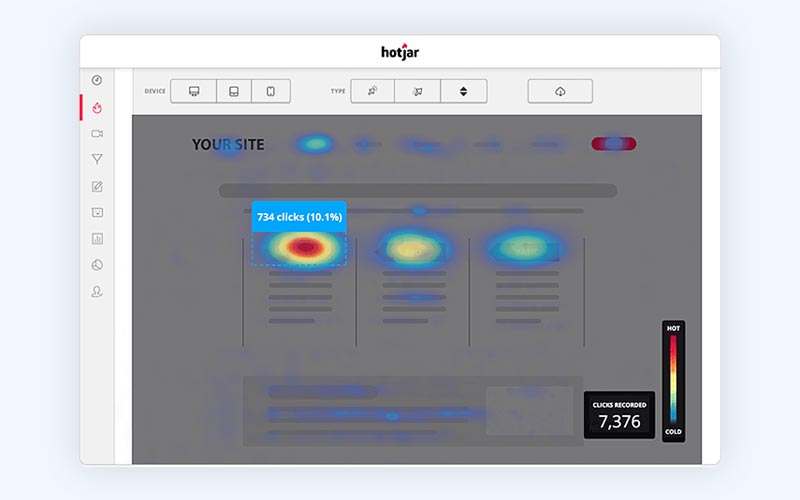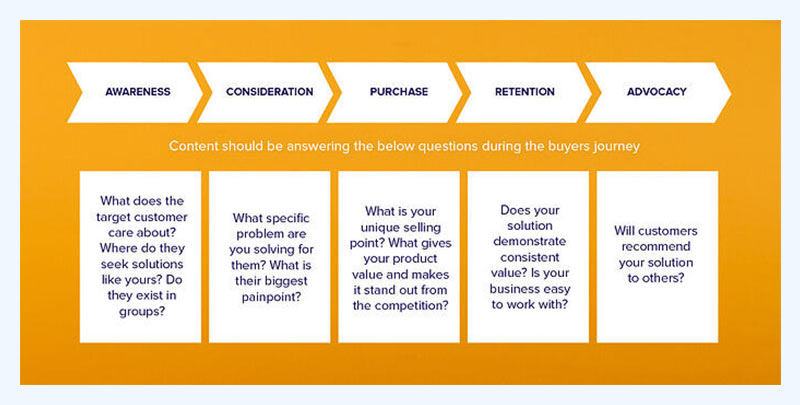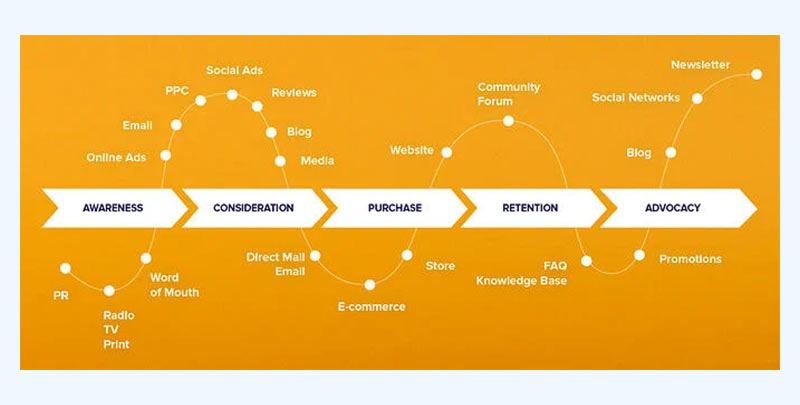
Optimizing the journey a customer takes from finding a brand to making a purchase is an essential step toward increasing ecommerce conversions.
An ecommerce customer journey map is a great way to analyze customer experience and identify any blockers visitors face that prevent them from making a purchase.
This is Carts Guru's ultimate guide to creating an ecommerce customer journey map.
What we'll cover in this guide:
- What is an e-commerce customer journey?
- Why map your e-commerce customers' experience?
- Step 1: Define customer personas
- Step 2: Analyze relevant data
- Step 3: Identify key touch-points
- Step 4: Create an e-commerce customer journey map
- Step 5: Using an e-commerce customer journey map
- Conclusion
Let's get started.
What is an ecommerce customer journey?
An ecommerce customer journey begins with one of two key things, a problem to solve, or an opportunity to grasp, ie. a ‘need’ or a ‘want’.
Let’s look at purchasing a new exercise bike as an example. The customer journey could begin with a problem, ie. their old bike is broken or out of date. In contrast, it could start with an opportunity, like a tempting advert that sparks the customer’s interest in the new bike.
Customers happy with their current brand will stay loyal to them, but for customers wanting to switch to a new brand the first step in the journey will be a competitor analysis.
Potential customers read reviews and testimonials, ask friends and family for advice, and compare the pricing of various brands. They may go back and forth a few times before making a final decision.
Once the customer has decided on a product, they then return to a website, find the product, complete the purchase, and wait for their item to arrive.
The customer’s journey doesn’t end when they receive their order. E-merchants need to keep customers engaged to encourage repeat purchases and drive brand loyalty. Loyal customers are the lifeblood of any successful e-commerce business, they leave positive reviews, provide social proof to friends and family, and continue to purchase year after year.
Why map an ecommerce customers' experience?
It’s not enough for an e-commerce store to sell great products. There's an abundance of choices easily available online, and customers are searching for something more. They want an amazing, memorable experience.
The best way for an e-merchant to deliver that is through a highly personalized customer journey. E-merchant’s need to analyze the entire process each customer goes through when buying a product, then work to improve that journey. This means customizing every detail, from the very first time a customer comes across a brand to the day they become an advocate.
An e-commerce customer journey map is the logical way to organize all these complicated data points. E-merchants can visualize the customer journey and clearly see where any problems lie.
Essentially, a customer journey map should help e-merchants do the following:
- Provide a smooth journey that helps customers solve problems and achieve goals
- Remove friction and obstacles in the buying process
- Make the brand experience enjoyable and recommendable
Step 1: Define customer personas
It's impossible to design a map without knowing who it's for. E-merchants need to have a clear picture of their target customer groups before they can build the perfect journey for them.
In order to define a customer persona, e-merchants need to ask themselves the following questions:
- Who's buying from you right now? Find out their age, gender, location, occupation, income level, and interests.
- Who benefits from your product?
- What are their pain points, goals and dreams?
Customer personas shouldn't be vague. Combine common traits into numerous specific personas with memorable characteristics, even a name. Include any objections they might have.
For example, an e-commerce store selling silver fashion jewelry might have the following customer persona:
Katie, a single 26-year-old female who studied advertising, and works in a marketing company, earning £28,000 a year. She lives with housemates in London and buys clothes from Zara and Cos, often shops on her mobile phone. She enjoys meeting friends for drinks and dinner, yoga and goes on 2 holidays a year. She likes affordable but good quality, unique jewelry. Potential obstacles: high prices and a website that isn't mobile-friendly.

Create as many personas as are relevant, then design a separate customer journey map for each persona.
Step 2: Analyze relevant data
E-merchants need to dig deep into any available data about customer interactions with their e-commerce website and social media pages.
The Google Analytics Behavior Flow Report is a great way to track this. The report shows the flow of traffic through a website that e-merchants can use to find out the common paths, and determine which ones result in more sales.
Are people going directly to checkout after viewing a product, or going back to browse more options?
Hotjar is another powerful tool that shows users colorful, visual heat maps of how visitors interact with a website. E-merchants can track details like mouse hover, clicks, attention, and scroll.
Heat maps essentially tell e-merchants how visitors interact with their site. From this, e-merchants can determine which website elements appeal to visitors, and which are not as useful.

Another key metric is cart abandonment. Find out how many customers make it to check out but leave before completing the purchase. E-merchants can track cart abandonment and automate emails, SMS, and Funnels to bring customers back to complete the purchase.
Similarly, e-merchants can gather data by simply speaking with customers. Conduct surveys and encourage customers to write testimonials or reviews. Read through customer queries and analyze their conversations with support services.
When measuring data, look out for patterns. Where are customers dropping off? Which pages do customers visit most, and in what order? Which pathways lead to the most sales?
E-merchants need to understand these patterns of user behavior before they can optimize an e-commerce customer journey.
Step 3: Identify key touch-points
A touchpoint is any time a customer or prospect comes into contact with a brand.
E-merchants need to make a list of every possible way a customer could interact with their brand. This list should include everything from seeing a social media ad to a search result, receiving a retargeting email, leaving a review, or speaking with customer support.
Divide the list into three categories - before, during, and after purchase. There will be a lot of crossover between the three categories.
At this stage, e-merchants will start seeing things from the customers' point of view.
Step 4: Create an e-commerce customer journey map
We often see e-commerce customer journeys divided into three stages - awareness, consideration, and decision.
However, what about after the purchase? Repeat purchasing, positive customer reviews, and social proof are all essential to e-commerce success.
Because of this, e-merchants should divide a customer journey map into five stages:
- Awareness
- Consideration
- Purchase
- Retention
- Advocacy
For each of the five stages, identify the key touch-points and the customer’s emotions, goals, and needs. Then, establish the brand's goal and actions to take at each stage.

Let's examine each stage of the journey in more detail.
Awareness
In the awareness stage, customers are just finding out who a brand is and what they represent.
They may have discovered the brand passively through an advertisement, social media or blog post, or actively through organic search.
Therefore, at this stage, the goal of an e-merchant is educating, answering questions, and establishing expertise on the relevant subject matter.
E-merchants need to gain the trust of potential customers, generate some interest, and convince them to find out more.
Consideration
In this stage, a brand has sparked the customers interest. They’re considering a specific product, but they may be weighing up different options and looking at similar products on competitor’s sites.
Potential customers might do research outside of the pre-defined customer journey, and look at things like social media pages and customer reviews. In this stage, e-merchants may have success in winning customers with a retargeting ad.
At this stage, the primary goals for an e-merchant are to position their product as the perfect solution, explain its advantages, justify the price, keep customers interested, and win their trust.
Purchase
Once the customer has decided to purchase, an e-merchant’s main goal is to remove any friction that might cause them to abandon their cart. Touch-points at this phase include the website checkout as well as social media, email, or telephone support.
Ensure that the checkout process is quick and simple with no blockers to purchase. If customers need to sign up for a membership or fill out unnecessary information at checkout they might give up and go elsewhere.
Customers may also have some final questions before they purchase, and brands that provide attentive customer service and help customers choose the right product stand a better chance of converting a sale.
Up to the last minute, e-merchants should re-emphasize their value proposition, reinforce customer’s decisions, and create a sense of urgency by showing limited availability.
Retention
Don't forget about customers after they've made a purchase. Repeat customers are vital for long-term e-commerce growth, so e-merchants need to work hard at retaining newly won customers.
Automatically enroll customers in a multi-channel post-purchase campaign and keep them engaged with regular emails and SMS messages.
E-merchants can ask customers for feedback, answer any questions they have, and send personalized offers relevant to their purchase. Build a community of loyal customers and keep them up to date on product releases, invite them to special sale events, and reward them with VIP deals.;
Advocacy
Social proof is an invaluable asset for e-merchants. Treat customers who go on to become brand advocates like the VIPs that they are.
Keep in touch with VIP customers via email and SMS campaigns. Ask VIP customers to join rewarding affiliate programs, give valuable brand feedback, and post about specific products or events on their social media sites.
Brands can even acquire testimonials from these loyal customers to publish on their website or blog.
Thank VIP customers for spreading brand awareness with exclusive offers and discounts and make sure they know their efforts are valued.

Step 5: Using an ecommerce customer journey map
An e-commerce customer journey map should help e-merchants answer the following questions:
- How do customers discover your product?
- What research do customers do before making a purchase?
- What "moments of truth" lead to sales or abandonment?
- Do customers consider any of your competitors?
- Do customers have a positive experience on your site?
- How could you improve the experience?
- At what stage in the journey are you losing customers?
The map should tell e-commerce store owners where they need to invest more time and resources.
For example, if people are leaving an online store after waiting too long for a response from customer service, invest time and effort into supplying 5-star support.
If visitors aren't reading through product descriptions, try simplifying them.
If potential customers leave because of unexpected shipping costs, reduce them, or make them clear upfront.
Conclusion
Although it may seem like a long and complicated process, mapping out a detailed e-commerce customer journey is absolutely worth it.
As a result, e-merchants will be able to streamline and optimize the customer’s journey to purchase and beyond.
Throughout the process, e-merchants will learn to empathize with website visitors and adopt a more customer-focused mentality. Furthermore, they will know where to invest the most time and money to get results.
.jpg)

